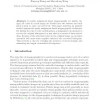Free Online Productivity Tools
i2Speak
i2Symbol
i2OCR
iTex2Img
iWeb2Print
iWeb2Shot
i2Type
iPdf2Split
iPdf2Merge
i2Bopomofo
i2Arabic
i2Style
i2Image
i2PDF
iLatex2Rtf
Sci2ools
KES
2005
Springer
2005
Springer
Analysis of Parity Assignment Steganography in Palette Images
Abstract. In parity assignment-based steganography for palette images, all colors in a host image are divided into two subsets, and each pixel is used to carry one secret bit. This paper describes an analytic method against the parity assignment-based steganographic techniques. By finding the rule of color modifications, a steganalyst can attempt to recover the original histogram in a way that is a reverse of data embedding. Because of the abnormal colors in the original image, an excessive operation will cause some negative values in the recovered histogram. This provides a clue for revealing the presence of secret message and estimating the length of embedded bit sequence.
Assignment-based Steganographic Techniques | KES 2005 | Parity Assignment-based Steganography | Secret Bit |
| Added | 28 Jun 2010 |
| Updated | 28 Jun 2010 |
| Type | Conference |
| Year | 2005 |
| Where | KES |
| Authors | Xinpeng Zhang, Shuozhong Wang |
Comments (0)

